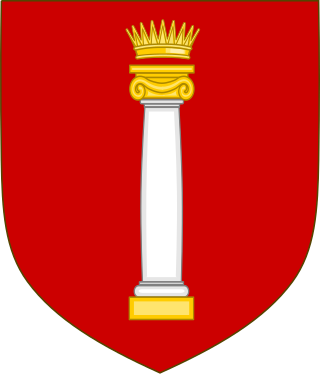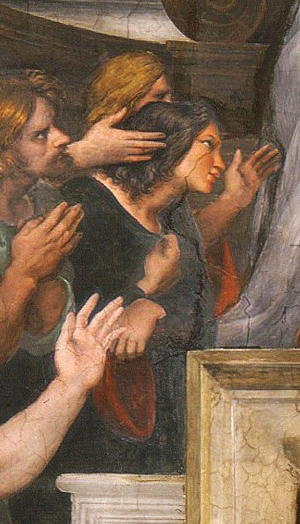
The House of Colonna, also known as Sciarrillo or Sciarra, is an Italian noble family, forming part of the papal nobility. It was powerful in medieval and Renaissance Rome, supplying one pope and many other church and political leaders. The family is notable for its bitter feud with the Orsini family over influence in Rome, until it was stopped by papal bull in 1511. In 1571, the heads of both families married nieces of Pope Sixtus V. Thereafter, historians recorded that "no peace had been concluded between the princes of Christendom, in which they had not been included by name".

The House of Orsini is an Italian noble family that was one of the most influential princely families in medieval Italy and Renaissance Rome. Members of the Orsini family include five popes: Stephen II (752–757), Paul I (757–767), Celestine III (1191–1198), Nicholas III (1277–1280), and Benedict XIII (1724–1730). The family also included 34 cardinals, numerous condottieri, and other significant political and religious figures. The Orsini are part of the Black nobility who were Roman aristocratic families who supported the Popes in the governance of the Papal States.

Pope Julius II was head of the Catholic Church and ruler of the Papal States from 1503 to his death, in February 1513. Nicknamed the Warrior Pope, the Battle Pope or the Fearsome Pope, it is often speculated that he had chosen his papal name not in honor of Pope Julius I but in emulation of Julius Caesar. One of the most powerful and influential popes, Julius II was a central figure of the High Renaissance and left a significant cultural and political legacy. As a result of his policies during the Italian Wars, the Papal States increased their power and centralization, and the office of the papacy continued to be crucial, diplomatically and politically, during the entirety of the 16th century in Italy and Europe.

Bartolomeo d'Alviano was an Italian condottiero and captain who distinguished himself in the defence of the Venetian Republic against the Holy Roman Emperor Maximilian.

Raffaele Sansoni Galeoti Riario was an Italian cardinal of the Renaissance, mainly known as the constructor of the Palazzo della Cancelleria and the person who invited Michelangelo to Rome. He was a patron of the arts. He was also the first adolescent to be elevated in the College of Cardinals in the history of the Holy See.

Marcantonio II Colonna, Duke of Tagliacozzo and Duke and Prince of Paliano, was a Roman aristocrat who served as Viceroy of Sicily in the service of the Spanish Crown, general of the Spanish forces, and Captain General of the Church. He is best remembered for his part as the admiral of the Papal fleet in the Battle of Lepanto. He was "one of the most illustrious land and sea captains of the 16th century."

The Duchy of Sora was a semi-independent state in Italy, created in 1443 by King Alfonso I of Naples and dissolved in 1796. It occupied the south-eastern part of what is today Lazio, bordering what is now Abruzzo. Its capital was first Sora, and later, under the Boncompagni family, Isola di Sora.

Francesco Maria I della Rovere was an Italian condottiero, who was Duke of Urbino from 1508 to 1516 and, after retaking the throne from Lorenzo II de' Medici, from 1521 to 1538.

Paolo Giordano Orsini was an Italian nobleman, and the first duke of Bracciano from 1560. He was a member of the Roman family of the Orsini.

The Diocese of Frascati is a Latin suburbicarian see of the Diocese of Rome and a diocese of the Catholic Church in Italy, based at Frascati, near Rome. The bishop of Frascati is a Cardinal Bishop; from the Latin name of the area, the bishop has also been called Bishop of Tusculum. Tusculum was destroyed in 1191. The bishopric moved from Tusculum to Frascati, a nearby town which is first mentioned in the pontificate of Pope Leo IV. Until 1962, the Cardinal-Bishop was concurrently the diocesan bishop of the see. Pope John XXIII removed the Cardinal Bishops from any actual responsibility in their suburbicarian dioceses and made the title purely honorific.

The 1492 papal conclave was convened after the death of Pope Innocent VIII. It was the first papal conclave to be held in the Sistine Chapel.

Giovanni Domenico de Cupis (1493–1553) was an Italian Cardinal, created by Pope Leo X in the consistory of 1 July 1517.

Felice della Rovere, also known as Madonna Felice, was the illegitimate daughter of Pope Julius II. One of the most powerful women of the Italian Renaissance, she was born in Rome around 1483 to Lucrezia Normanni and Cardinal Giuliano della Rovere. Felice was well educated, became accepted into close courtly circles of aristocratic families, and formed friendships with scholars and poets through her education and genuine interest in humanism. Through the influence of her father, including an arranged marriage to Gian Giordano Orsini, she wielded extraordinary wealth and influence both within and beyond the Roman Curia. In particular, she negotiated peace between Julius II and the Queen of France, and held the position of Orsini Signora for over a decade following the death of her husband in 1517. Felice further increased her power through a castle that she bought with money received from her father, the Castle at Palo, and through her involvement in the grain trade.

Giulio della Rovere, also known as Giulio Feltrio della Rovere was an Italian Cardinal of the Catholic Church and a member of the della Rovere family.

Borgia is a historical drama television series created by Tom Fontana for Canal+, ZDF, ORF, and Sky Italia. The show recounts the Borgia family's rise to power and subsequent domination of the Papal States during the Renaissance.

The Sacchetti family is an Italian noble family originating in Tuscany, now resident in Rome, whose earliest documented member Merlo lived during the late 10th and early 11th centuries. The name of the family is derived from one or more members known as Sacchetto. According to Ugolino di Vieri (1438–1516),"nobile Sacchetti genus est, moenia primus romanus sangius".

Vittoria Farnese, also known as Vittoria, Princess of Parma, and by her married name Vittoria Farnese della Rovere, was an Italian noblewoman, Duchess consort of Urbino from 1548 until 1574 by marriage to Guidobaldo II della Rovere, Duke of Urbino.

The Cesi family is an Italian noble family which belonged to the high aristocracy of Rome and the Papal States.
Laura Orsini, Lady of Carbognano was an Italian noblewoman, daughter of Giulia Farnese and, presumably, of her lover Pope Alexander VI Borgia.

Gian Giordano Orsini, IV Lord of Bracciano was an Italian nobleman and condottiero. He married Felice della Rovere and was the son-in-law of Pope Julius II.

















